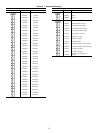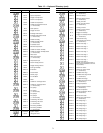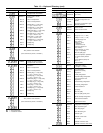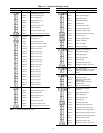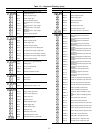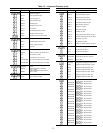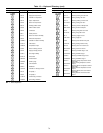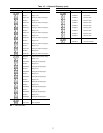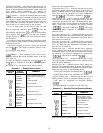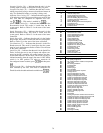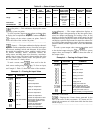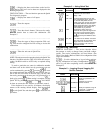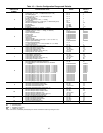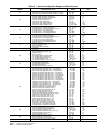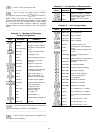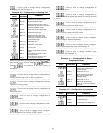
STATUS FUNCTION — The status function shows the cur-
rent status of alarm (diagnostic) codes, operating modes, set
points, all measured system temperatures, output values, and
input values. These subfunctions are defined on
pages 78-80. Refer to Table 11 for additional information.
(Alarms) — Alarms are messages that one or more
faults have been detected. Each fault is assigned a code num-
ber which is reported with the alarm. (See Table 14 for
code definitions.) The codes indicate failures that cause the
unit to shut down, terminate an option (such as reset), or
result in the use of a default value as the set point.
Up to 32 alarm codes can be stored at once. To view
them in numerical sequence, press to enter the
alarm display and then press to move to the individual
alarm displays. Press after a code has been displayed
and the meaning of the code will scroll across the screen.
See Example 1.
If an input or output point which has generated an alarm
resets (returns to a range within its limits), the alarm code is
deleted from the list.
A historical sequence of the last 9 alarms can be found
using the key. See Display Functions, History Func-
tion section for more details.
------------------------------------------------
(Modes) — The operating mode codes are dis-
played to indicate the current operating status of the unit.
(See Table 14)
To enter the MODES subfunction, press and use
the key to determine if more than one mode applies.
See Example 2 to read current mode with expansion.
Example 1 — Reading Alarm Codes
KEYBOARD
ENTRY
DISPLAY
RESPONSE
COMMENTS
TUE 12:45
Keyboard has not been used for
at least 10 minutes; alternating
summary display appears on
screen
MODE 23
3 ALARMS
3 ALARMS 3 alarms detected
ALARM 71 First alarm code
SPACE
TEMPERATURE
Explanation of alarm code
LOW LIMIT
ALARM 76 Second alarm code
RETURN AIR
TEMPERATURE
Explanation of alarm code
HIGH LIMIT
ALARM 83 Third alarm code
RELATIVE
HUMIDITY
LOW LIMIT
Explanation of alarm code
The modes are explained below:
Temperature Reset (21) — Indicates that the unit is using
temperature reset to adjust the supply-air set point. The set
point is modified based on space temperature (VAV units
only). Unit must be configured for space temperature
reset ( ). (This mode is enabled by .)
Demand Limit (22) — On CV (constant volume) units, this
mode indicates that the fan is being held off by the De-
mand Limit option. On VAV units, it indicates that the max-
imum IGV position is being limited by the Demand Limit
option. Units must be configured for demand limiting
( ). This mode is enabled by , and is only
available on units connected to the Carrier Comfort
Network (CCN).
Unoccupied Heating (23) — Indicates that the space tem-
perature is below the Unoccupied Heating set point and the
unit is on. When the space temperature rises above the set
point the unit is turned off.
Unoccupied Cooling (24) — Indicates that the space tem-
perature is above the Unoccupied Cooling set point and the
unit is on. When the space temperature falls below the set
point the unit is turned off.
Optimal Start (26) — Indicates that the unit is operating
in the Optimal Start mode and is trying to achieve the
Occupied set point. On VAV units this is referred to as morn-
ing warm-up. Unit must be configured for optimal start
( ). This mode is enabled by .)
Unoccupied Mode (27) — Indicates that the unit is in the
Unoccupied mode as determined by its time schedule. In this
mode the unit is turned off.
Optimal Stop (29) — Indicates that the unit is being con-
trolled to its expanded Occupied set points. The space tem-
perature is allowed to drift to its expanded Occupied set points
during the last portion of the Occupied period.
Unit must be configured for Optimal Start ( ).
Optimal Stop mode is only applicable to CV units.
Occupied Heating (30) — Indicates that the unit is in the
Heating mode to satisfy its Occupied Heating set point.
Units must be configured for Occupied Heating
().
Occupied Heating is available on VAV units only.
Example 2 — Reading Current Operating Modes
KEYBOARD
ENTRY
DISPLAY
RESPONSE
COMMENTS
TUE 12:45
MODE 31
Keyboard has not been
used for at least 10 min-
utes; alternating summary
display appears on screen.
MODE
Modes subfunction of
status function
MODE 31 Mode 31 is in effect
OCCUPIED COOLING Explanation of code 31
MODE 22 Mode 22 is in effect
DEMAND LIMIT Explanation of code 22
NOTE: The first mode is the primary operating mode. The second
mode is the secondary operating mode, if applicable.
78



